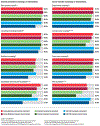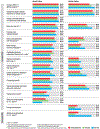Cancer Prevention in Primary Care: Perception of Importance, Recognition of Risk Factors and Prescribing Behaviors
- PMID: 31862335
- PMCID: PMC7293933
- DOI: 10.1016/j.amjmed.2019.11.017
Cancer Prevention in Primary Care: Perception of Importance, Recognition of Risk Factors and Prescribing Behaviors
Abstract
Purpose: Acceptability and uptake of cancer preventive interventions is associated with physician recommendation, which is dependent on physician familiarity with available preventive options. The goal of this study is to evaluate cancer prevention perceptions, understanding of breast and ovarian cancer risk factors, and prescribing behaviors of primary care physicians.
Methods: We conducted cross-sectional. Web-based survey of 750 primary care physicians (250 each for obstetrics/gynecology, internal medicine, and family medicine) in the United States. Survey respondents were recruited from an opt-in health care provider panel.
Results: Perception of importance and the practice of recommending general and cancer-specific preventive screenings and interventions significantly differed by provider type. These perceptions and behaviors reflected the demographics of the population that the primary care physicians see within their respective practices. The majority of respondents recognized genetic/hereditary risk factors for breast or ovarian cancer, while epidemiologic or clinical risk factors were less frequently recognized. Prescribing behaviors were related to familiarity with the interventions, with physicians indicating that they more frequently reinforced a specialist's recommendation rather than prescribed a preventive intervention.
Conclusions: Cancer prevention perceptions, recognition of cancer risk factors, and prescribing behaviors differ among practice types and were related to familiarity with preventive options. Cancer prevention education and risk assessment resources should be more widely available to primary care physicians.
Keywords: Cancer prevention; Primary care physicians; Survey.
Published by Elsevier Inc.
Conflict of interest statement
The authors declare no conflict of interest.
Figures


References
Publication types
MeSH terms
Grants and funding
LinkOut - more resources
Full Text Sources
Medical

